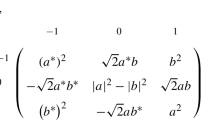Abstract
The classical gravity model used for planetary navigation is a harmonic expansion of Legendre polynomials and associated functions. The harmonic expansion diverges when the orbital radius is less than that of the Brillouin sphere. An alternative method for computing gravitational acceleration is described, and shape models of a brick and the asteroid Eros are used as examples. Computation is reduced to a surface integral by first analytically integrating with respect to r, assuming constant density. The result is evaluated far more rapidly. Results are compared to those generated from a polyhedron model and to those generated from a classical harmonic expansion.
Similar content being viewed by others
References
CASSOTO, S. and MUSSOTTO, S. “Methods for Computing the Potential of an Irregular, Homogeneous, Solid Body and its Gradient,” paper AIAA 2000-4023, Proceedings of AIAA/AAS Astrodynamics Specialist Conference, Denver, CO, August 14–17, 2000.
CASSOTO, S. “Numerical Experiments on the Convergence of Spherical and Spheroidal Harmonic Representations of the External Potential Inside the Brillouin Sphere,” paper AAS 01-226, Proceedings of AIAA/AAS Astrodynamics Space Flight Mechanics Meeting, Santa Barbara, CA, February 11–15, 2001.
WERNER, R. A. “The Gravitational Potential of an Homogeneous Polyhedron, or Don’t Cut Corners,” Celestial Mechanics & Dynamical Astronomy, Vol. 59, 1994, pp. 253–278.
WERNER, R. A. and SCHEERES, D. J. “Exterior Gravitation of a Polyhedron Derived and Compared with Harmonic and Mascon Gravitation Representations of Asteroid 4769 Castalia,” Celestial Mechanics & Dynamical Astronomy, Vol. 65, 1997, pp. 313–344.
MILLER, J. K., et. al. “Determination of Shape, Gravity, and Rotational State of Asteroid 433 Eros,” Icarus, Vol. 155, 2002.
MACMILLAN, W.D. The Theory of the Potential, McGraw-Hill, New York, 1930. Republished by Dover, New York, 1958.
KELLOG, O. D. Foundations of Potential Theory, Murray Printing Co., New York, 1929.
HEISKANEN, W. A. and MORITZ, H. Physical Geodesy, W. H. Freeman and Co., San Francisco, 1967.
Author information
Authors and Affiliations
Rights and permissions
About this article
Cite this article
Weeks, C., Miller, J.K. A Gravity Model for Navigation Close to Asteroids and Comets. J of Astronaut Sci 52, 381–389 (2004). https://doi.org/10.1007/BF03546369
Published:
Issue Date:
DOI: https://doi.org/10.1007/BF03546369




